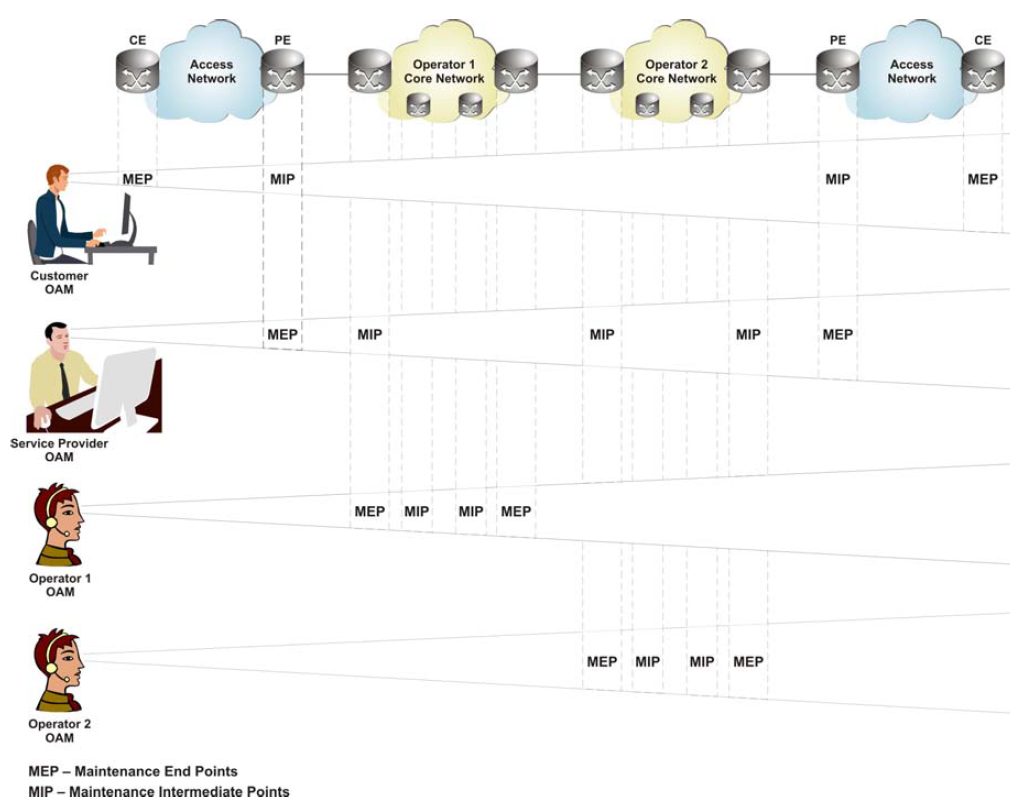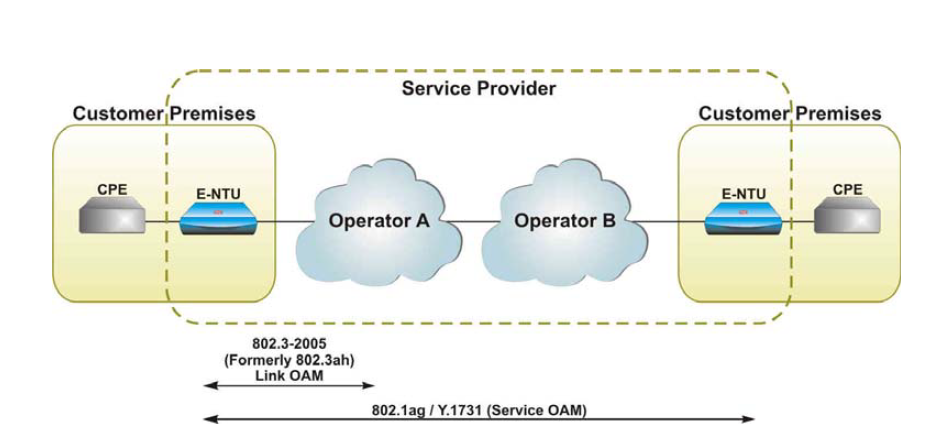Ethernet OAM Standards
A reference guide to Ethernet OAM standards: Ethernet Link, Connectivity and Service OAM.
Overview
A reference guide to Ethernet OAM standards: Ethernet Link, Connectivity and Service OAM. IEEE 802.3-2005 (previously 802.3ah, Clause 57), IEEE 802.1ag and ITU-T Y.1731OAM is a set of functions designed to monitor network operation in order to detect network faults and measure its performance. As Ethernet evolved from enterprise-level LANs to carrier-class networks and services, it required automated end-to-end management and monitoring by service providers. As a result, Ethernet is the most recent communications protocol to adopt OAM capabilities such as connectivity verification, fault detection, performance monitoring, and alarm indication.
OAM functionality allows network operators to measure quality of service attributes such as Availability, Frame Delay, Frame Delay Variation (“Jitter”) and Frame Loss. Such measurements enable identification of problems before they escalate so that users are not impacted by network defects. Furthermore, these capabilities allow the operators to offer binding SLAs and generate new revenues from rate- and performance-guaranteed service packages that are tailored to the specific needs of their customers.
Effective end-to-end service control also enables carriers to avoid expensive truck rolls to locate and contain faults thereby facilitating reduction of maintenance costs. Intrinsic OAM functionality is therefore essential in any carrier class technology and is a ‘must have’ capability in intelligent Ethernet network termination units.
What’s in the white paper:
- Ethernet Link OAM
- Ethernet Service OAM
- OAM Functions and Mechanisms for Ethernet Based Networks
- Service OAM Requirements and Framework
Introduction
OAM is a set of functions designed to monitor network operation in order to detect network faults and measure its performance. As Ethernet evolves from enterprise-level LANs to carrier-class networks and services, it requires automated end-to-end management and monitoring by service providers. As a result, Ethernet is the most recent communications protocol to adopt OAM capabilities such as connectivity verification, fault detection, performance monitoring, and alarm indication. OAM functionality allows network operators to measure quality of service attributes such as Availability, Frame Delay, Frame Delay Variation (“Jitter”) and Frame Loss. Such measurements enable identification of problems before they escalate so that users are not impacted by network defects. Furthermore, these capabilities allow the operators to offer binding SLAs and generate new revenues from rate- and performance-guaranteed service packages that are tailored to the specific needs of their customers.
Effective end-to-end service control also enables carriers to avoid expensive truck rolls to locate and contain faults thereby facilitating reduction of maintenance costs. Intrinsic OAM functionality is therefore essential in any carrier class technology and is a ‘must have’ capability in intelligent Ethernet network termination units.
OAM Standards
A significant milestone in making Ethernet services carrier-grade is the development of industry standards. The IEEE (Institute of Electrical and Electronics Engineers), ITU (International Telecommunication Union) and MEF (Metro Ethernet Forum), have been working in close cooperation to establish complementary, rather than overlapping, Ethernet OAM standards.
Ethernet Link OAM
IEEE Standard 802.3-2005 (previously 802.3ah, Clause 57) was originally developed for Ethernet in the First Mile (EFM) applications and was also known as “EFM OAM”. It relates to a single Ethernet link within a network. In addition to defining Ethernet delivery over copper, fiber and PON (Passive Optical Network) media, IEEE 802.3-2005 specifies the following link monitoring OAM procedures:
- Discovery
- Remote failure indication, including link fault, dying gasp and other critical event indications
- Remote loopback testing
- Link performance monitoring
- Management Information Base (MIB) variable retrieval
- Organization-specific functions
Ethernet Service OAM
IEEE Standard 802.1ag covers the scope of Ethernet service over any path, whether a single link or end-to-end, enabling service providers to fully monitor Ethernet service regardless of the layers supporting the service, the network path over which Ethernet traffic is traversing, or the various network operators involved. IEEE 802.1ag is also termed “Connectivity Fault Management (CFM)”. It divides a network into maintenance domains in the form of hierarchy levels, which are then allocated to users, service providers and operators. CFM assigns maintenance end points (MEPs) to the edges of each domain and maintenance intermediate points (MIPs) to ports within domains. This helps define the relationships between all entities from a maintenance perspective, to allow each entity to monitor the layers under its responsibility and easily localize problems.
The following procedures are included in IEEE 802.1ag standard:
- Connectivity check
- Loopback
- Link trace
OAM Functions and Mechanisms for Ethernet Based Networks
ITU-T Standard Y.1731 uses different terminology than IEEE 802.ag and adds the following Ethernet Service OAM features:
- Fault Management:
- Ethernet Alarm Indication Signal (ETH-AIS)
- Ethernet Remote Defect Indication (ETH-RDI)
- Ethernet Locked Signal (ETH-LCK)
- Diagnostics:
- Ethernet Test Signal (ETH-Test), including throughput measurements
- Performance Management:
- Frame Loss Measurements (ETH-LM)
- Frame Delay Measurements (ETH-DM)
- Frame Delay Variation Measurements
Service OAM Requirements and Framework
MEF Technical Specification 17 marks MEF’s effort to outline the requirements from Service OAM mechanisms, specifically among Metro Ethernet (ME) network elements. MEF 17 addresses the following Services OAM functionalities:
- Fault Management (including detection, verification, localization and notification)
- Performance Monitoring (including performance parameters measurements)
- Auto-discovery (including discovering service-aware network elements within provider networks)
- Intra-provider and inter-provider Service OAM

